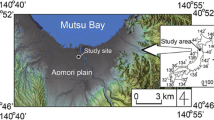Abstract
It has been shown that the redox potential of water saturated with hydrogen is −(500–700) mV. The time of the establishment of the potential is 24 h. The potential somewhat increases with increasing volume of hydrogen introduced to a reservoir with water and practically does not depend on the presence of additions in water, provided these additions are not reduced by hydrogen. The pH value of water does not change after the addition of hydrogen. In a glass vessel with a metallic cover resting on the side, no decrease in potential during the 2.5-month storage was observed. In plastic bottles, the content of hydrogen decreased; on storage for more than two weeks, it disappeared almost completely, and as a result, the potential increased after storage for three to four weeks to a level near zero. In an open vessel, the potential remained negative for two days.
Similar content being viewed by others
References
I. Yu. Petrushanko and V. I. Lobyshev, Biofizika 46(3), 389 (2001).
I. Yu. Petrushanko and V. I. Lobyshev, Biofizika 49(1), 22 (2004).
A. I. Kloss, Dokl. AN SSSR 303(6), 1403 (1988).
B. I. Leonov, V. I. Prilutskii, and V. M. Bakhir, Physocochemical Aspects of the Biological Action of Electrochemically Activated Water (VNIIMT, Moscow, 1999) [in Russian].
A. I. Miroshnikov, Zh. K. Masalimov, and V. I. Bruskov, Biofizika 49(1), 32 (2004).
D. Dobosh, Electrochemical Constants (Mir, Moscow, 1980) [in Russian].
N. A. Aristova and I. M. Piskarev, Santekh. Otopl. Kondits., no. 9, 26 (2005).
N. A. Aristova and I. M. Piskarev, in Encyclopedia of Low-temperature Plasma, Ed. by Yu. A. Lebedev, N. A. Plate, and V. E. Fortov (Yanus-K, Moscow, 2006), Ser. B. Vol. XI-5, pp. 310–344 [in Russian].
I. M. Piskarev, V. A. Ushkanov, P. P. Likhachev, and T. S. Myslivets, Electronic Journal “Issledovano v Rossii” (Investigated in Russia), 023, 230 (2007). http://zhurnal.ape.relarn.ru/articles/2007/023.pdf.
Author information
Authors and Affiliations
Additional information
Original Russian Text © I.M. Piskarev, V.A. Ushkanov, N.A. Aristova, P.P. Likhachev, T.S. Myslivets, 2010, published in Biofizika, 2010, Vol. 55, No. 1, pp. 19–24.
Rights and permissions
About this article
Cite this article
Piskarev, I.M., Ushkanov, V.A., Aristova, N.A. et al. Establishment of the redox potential of water saturated with hydrogen. BIOPHYSICS 55, 13–17 (2010). https://doi.org/10.1134/S0006350910010033
Received:
Accepted:
Published:
Issue Date:
DOI: https://doi.org/10.1134/S0006350910010033




